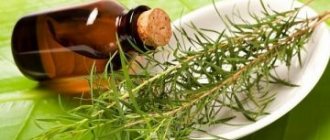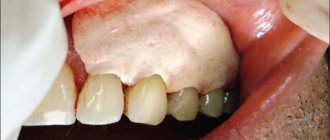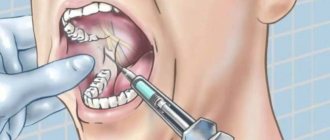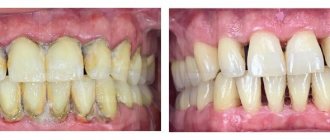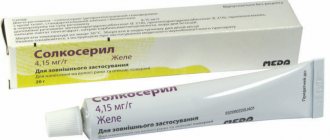01.12.2019
Over time, tooth enamel begins to darken, losing its natural tone. Most people think about ways to whiten their teeth at home. There are many ways to do this yourself. One of the safe, affordable and effective remedies is tea tree oil.
Use in dentistry
The oil is actively used by dentists due to its medicinal properties:
- Strengthens gums and relieves inflammation. Due to its ability to quickly restore tissue and destroy pathogenic infections, it is recommended to rinse your mouth with oil for periodontal disease, gingivitis, and periodontitis. After 2 weeks of use, gum bleeding stops.
- Removing solid deposits. The oil softens not only soft plaque on teeth, but also hard plaque. With regular use, the stones begin to lag behind the enamel, that is, they break off.
- Elimination of unpleasant odor from the oral cavity. Plaque on teeth is a collection of bacteria. By getting into the membranes of pathogenic cells, tea tree neutralizes the infection. The plaque is removed, the smell disappears.
- Prevention of caries. The infection contaminates and destroys teeth, causing an inflammatory process - caries. By rinsing your mouth after eating, you can prevent the development of caries.
Thanks to its disinfectant, antibacterial, antimicrobial, healing properties, essential oil helps heal microcracks, injuries on the oral mucosa, strengthen gums and enamel.
Benefits of clove essential oil
It helps relieve throbbing pain in the tooth, thanks to a substance in its composition called eugenol. Clove oil is obtained from the clove tree, using the buds, leaves and the tree trunk itself. Clove oil fights gum inflammation and has analgesic and antiseptic properties.
It can be prepared at home, for this you need to take edible cloves, throw five buds into one glass of vegetable oil and boil, then cool and apply a cotton swab dipped in this oil to the sore tooth.
Effect on enamel
Teeth whitening is a gentle and strengthening procedure. Enamel, having a porous structure, suffers from plaque, which settles on the surface and instantly penetrates the pores. Bacteria and viruses immediately enter the tissue, causing an inflammatory process. Thanks to its astringent properties, teeth cleaning oil envelops the enamel, creating a protective film. Therefore, after using it, it is difficult for bacteria to penetrate into the pores. In addition, disinfectant properties help destroy pathogenic infections and prevent the development of inflammation.
After using tea tree oil, the enamel will not only become 2 shades lighter, but also strengthen and be protected from infection.
General information
Melaleuca is an exclusively Australian plant. After water distillation, valuable essential oil is obtained from the juice of the leaves. It is a clear, light yellow liquid with an odor combining camphor and wood. Containing a huge number of terpineols, it has powerful antimicrobial, anti-inflammatory, wound-healing, and soothing effects. Aborigines have used it since ancient times to cure serious illnesses, skin diseases, bites and burns.
Today its beneficial properties are used in medicine and cosmetology. It is an integral component of many cosmetics and medications. The main use of the oil was as a teeth-lightening agent. Their tone changes when plaque is removed, which often causes the enamel to darken.
Selection rules
Unfortunately, not all oil manufacturers are decent. Some sell low-quality goods for selfish reasons. That's why there are negative reviews from people. They write that the tea tree oil bleaching method did not help. You need to know how to choose the right product, which companies are reputable manufacturers. Here's what you need to pay attention to when purchasing.
Name
The label should not contain phrases such as aromatic, perfumery product, identical to natural, a mixture of therapeutic, aromatherapy class. There is no therapeutic effect in such compositions. The oil content in the products is minimal. Such grouping by class simply does not exist. The inscription on the bottle label must contain the phrase 100% natural essential oil. If it is not available, you should not purchase the product.
Capacity
Essential oils cannot be stored for long in clear or plastic bottles. Real oil is stored only in dark glass bottles. This protects the product from ultraviolet rays, which destroy its structure. In addition, plastic has the ability to enter into a chemical reaction with oil and change its properties, which is also unacceptable.
Bottle volume
The container with real essential oil has a volume of no more than 10 ml. If you are offered to purchase a product in a 30 ml bottle for 100 rubles, you should know that it is a fake.
Certificate
Be sure to ask for a quality certificate when purchasing oil. It shouldn't be a copy. This is a document with original, “wet” seals.
Chromatogram
Serious and expensive analysis of the product, allowing you to accurately determine its composition. Probably, the chromatogram can be called the only category that gives a comprehensive answer about the quality of the product.
The absence of a chromatogram on the packaging is a sign of a synthetic counterfeit, an inexpensive analogue.
Prices
Essential oil, like any natural component, cannot be cheap. To obtain a small bottle, a large amount of raw material must be processed.
Manufacturers
For teeth whitening, give preference to the following companies:
- Aromatics.
- Natural oils.
- Bioderma.
- Delarom.
- Estée Lauder.
- Nuxe.
- L'Occitane.
Products from these manufacturers comply with European quality standards. They can be used not only for local processing, but also for internal use.
You can determine the authenticity of a product using a simple test. Drop the mixture from the bottle onto the paper. Since the oil is transparent, it should not stain the paper. But if after 15 minutes. there is not a trace left of the drop, which means you are being offered to buy a fake consisting of alcohol and volatile solvents. This will not only not bring healing and whitening effects, but will also harm your health.
How to choose the right product?
Manufacturers often resort to various tricks to reduce the cost of goods. Some make oil in laboratory conditions, artificially recreating the composition of the original.
Others use cheap or second-class raw materials in production. And finally, a mixture of flavoring and solvent is often passed off as a quality product, labeled “100% natural.”
However, only real essential oil has a cosmetic effect, which can be distinguished by the following characteristics:
- label with the phrase "100% natural essential oil"
- dark glass bottle;
- the expiration date is indicated;
- the product indicates the manufacturer and its address, the botanical name of the plant;
- the neck of the bottle is equipped with a dosimeter;
- high price (about 500 rubles).
It is almost impossible to purchase high-quality oil in a regular store, so it is better to opt for online purchases. There are not too many trusted manufacturers, here are some of them:
- "Iris" (Russia);
- "Primavera Life" (Germany);
- "Aura Gacia" (USA);
- "Glorion" (Russia).
pros
The oil has the following benefits as a whitening agent:
- The effect on enamel is gentle. The composition does not contain abrasive particles that destroy and thin the enamel.
- The mucous membrane is not irritated. Oil, on the contrary, heals microcracks and promotes cell regeneration during gingivitis and stomatitis.
- Antiseptic effect. Destroys bacteria, viruses, microbes.
- A simple way to whiten. Teeth lightening with tea tree can be easily done at home.
- Price. The cost of oil is several times lower than the price of professional whitening in a dental office.
- An exceptionally natural product. Does not contain chemically aggressive components.
But only real oil has such advantages; this does not apply to fakes.
Cautions
Before we start the conversation, let us draw your attention to the fact that “folk” does not equal “safe”. There is a stereotype: if you use exclusively natural products, there will be no harm, all benefits. In fact, oils, for all the attractiveness of their origin, are very concentrated substances. This means that they can cause gum irritation, allergies, increased tooth sensitivity, and other problems.
Therefore, if you want to make your teeth lighter and definitely not harm their health, it is better to use professional methods or specialized products, such as ASEPTA PLUS GENTLE WHITENING toothpaste. It has a special multi-stage system that allows you to get visible results in just four weeks. Hydroxyapatite and potassium citrate, which are present in its composition, mineralize weakened enamel and prevent increased tooth sensitivity. And calamus and eleutherococcus extracts soothe gums.
Minuses
No matter how many positive aspects there are to whitening tooth enamel with oil, there is still a fly in the ointment:
- It will not be possible to achieve snow-whiteness. Using this method of whitening, you can return only the natural shade of the enamel. For a Hollywood smile, you will have to use professional lightening using special preparations.
- Eating products containing dyes and smoking will cause yellowing of the enamel.
- The first three minutes after the manipulations, the tongue goes numb, and taste perception changes.
- Not everyone likes a specific scent.
Another disadvantage is that if the bleaching agent gets into the stomach, nausea may occur.
Rinsing
One of the most common ways to prevent plaque from settling and give freshness to your breath.
Rinse your mouth after every meal. If this is not possible, rinse your mouth at least 2 times a day.
The composition is very simple to prepare: add 5 drops of essential oil to 200 ml of warm boiled water. Stir with a teaspoon and rinse your mouth 3 times.
Classical technique
To remove pigmentation from enamel and lighten teeth, you should use the following cleaning technique:
- Brush your teeth with a brush and toothpaste.
- Rinse your mouth.
- Place three drops of oil on a cotton pad and wipe your teeth thoroughly.
- Rinse your mouth with water.
You can also use the following recipe for whitening: mix 3 drops of tea tree oil and 1 tsp. lemon juice. These components have the ability to enhance each other's effectiveness.
Improving toothpaste
You can not only rinse your mouth with oil, but also brush your teeth in combination with toothpaste. This will help improve its quality and disinfect the oral cavity. Still, not all cleaning products have antiseptic properties (unlike tea tree).
Cleaning technique:
- After applying the paste to the brush, add 3 drops of oil;
- brush your teeth first in the lower jaw, then in the upper jaw;
- the nature of the movements is sweeping, circular;
- don’t forget to clean your tongue and inner cheeks;
- rinse your mouth with mineral or plain water.
To improve the effect, you can dip the brush in baking soda, then apply the paste and oil. Baking soda also has a whitening effect. But you can use it no more than once a week. Soda contains particles that, if used regularly, injure and destroy enamel.
Clinical researches
Clinical studies have proven that regular use of professional toothpaste ASEPTA GENTLE WHITENING for a month allows you to lighten tooth enamel by 1.5 tones, increases anti-caries effectiveness by 3.4 times and increases enamel remineralization by 2.6 times.
Sources:
- Report on determining/confirming the preventive properties of toothpaste “ASEPTA PLUS” GENTLE WHITENING” Author: doctor-researcher A.A. Leontyev, head Department of Preventive Dentistry, Doctor of Medical Sciences, Professor S.B. Ulitovsky First St. Petersburg State Medical University named after. acad. I.P. Pavlova, Department of Preventive Dentistry
- Clinical and laboratory assessment of the influence of domestic therapeutic and prophylactic toothpaste based on plant extracts on the condition of the oral cavity in patients with simple marginal gingivitis. Doctor of Medical Sciences, Professor Elovikova T.M.1, Candidate of Chemical Sciences, Associate Professor Ermishina E.Yu. 2, Doctor of Technical Sciences Associate Professor Belokonova N.A. 2 Department of Therapeutic Dentistry USMU1, Department of General Chemistry USMU2
- Report on the determination/confirmation of the preventive properties of personal oral hygiene products “ASEPTA PLUS” Remineralization doctor-researcher A.A. Leontyev, head Department of Preventive Dentistry, Doctor of Medical Sciences, Professor S.B. Ulitovsky First St. Petersburg State Medical University named after. acad. I.P. Pavlova, Department of Preventive Dentistry
- Clinical studies of antisensitive toothpaste “Asepta Sensitive” (A.A. Leontyev, O.V. Kalinina, S.B. Ulitovsky) A.A. LEONTIEV, dentist O.V. KALININA, dentist S.B. ULITOVSKY, Doctor of Medical Sciences, Prof. Department of Therapeutic Dentistry, St. Petersburg State Medical University named after. acad. I.P. Pavlova
- The role of anti-inflammatory rinse in the treatment of periodontal diseases (L.Yu. Orekhova, A.A. Leontyev, S.B. Ulitovsky) L.Yu. OREKHOVA, Doctor of Medical Sciences, Prof., Head of Department; A.A. LEONTIEV, dentist; S.B. ULITOVSKY, Doctor of Medical Sciences, Prof. Department of Therapeutic Dentistry of St. Petersburg State Medical University named after. acad. I. P. Pavlova
- Report on determining/confirming the preventive properties of toothpaste “ASEPTA PLUS” COFFEE and TOBACCO Author: doctor-researcher A.A. Leontyev, head Department of Preventive Dentistry, Doctor of Medical Sciences, Professor S.B. Ulitovsky. First St. Petersburg State Medical University named after. acad. I.P. Pavlova, Department of Preventive Dentistry
- Report on determining/confirming the preventive properties of commercially produced personal oral hygiene products: Asepta toothpaste used in combination with Asepta mouthwash and Asepta gum balm Head. Department of PFS Doctor of Medical Sciences Professor S.B. Ulitovsky St. Petersburg State Medical University named after Academician I.P. Pavlova. Faculty of Dentistry. Department of Preventive Dentistry.
Folk recipes
When using any recipe, avoid ingesting cleaning compounds.
Be sure to rinse your mouth thoroughly with water after the procedure.
Aloe and tea tree oil
For sensitive enamel, a mixture of 3 drops of oil and 1 tsp will be useful. aloe juice Rub the mixture into the surface of your teeth with your finger or apply the mixture onto a cotton pad.
Tea tree oil and mineral water
A solution consisting of 1 drop of oil and 1 tsp is good for lightening teeth. mineral water. Rub it into the enamel for 2-3 minutes after meals at least 2 times a day.
Lemon+soda+tea oil
Mix 1 tsp. soda, 0.5 tsp. freshly squeezed lemon juice to a paste consistency. Add 2 drops of oil and mix again until smooth. Dip your toothbrush into the mixture and gently massage your teeth. Leave the composition on the enamel for 1 minute. Do not touch your gums to avoid injuring them.
Use this cleaning method no more than once a week.
Secret No. 2: do not use the product in its pure form.
Tea tree oil is a natural antibiotic with very strong positive properties. It can have anti-inflammatory, wound-healing, deodorizing, antibacterial, analgesic, and antiviral effects. It is used in cosmetology (to treat skin rashes, to strengthen hair and nails), in aromatherapy and SPA, in the presence of burns and upper respiratory tract infections. And also in complex therapy to combat stomatitis, gingivitis and periodontitis. It helps to cope with bleeding gums, eliminates foul odor, and gives fresh breath in the morning and evening hours.
The drug is intended for external use only
All these properties are wonderful, but there are a few “buts” when using oil:
- do not use the product in its pure form if you have sensitive mucous membranes: in order not to cause numbness, burning and itching, redness and additional irritation, first mix a few drops of tea tree oil with olive, peach or sea buckthorn oils, or with a hundred milliliters of water (per 100 ml you will need 3, maximum 5-7 drops),
- do not allow the product to be swallowed: otherwise you may experience all the signs of poisoning of the body - vomiting, diarrhea, confusion, loss of coordination of movements.
Contraindications
Avoid the idea of teeth whitening in the following cases:
- Fragile, thinned enamel. This may be evidenced by constantly developing secondary caries.
- Pregnancy. During the procedure, it is rarely possible to avoid swallowing even a small amount of cleanser. It is harmful. To prevent negative effects on the fetus, you should avoid the procedure during pregnancy. In addition, even a slight impact on the enamel can cause its destruction. During pregnancy, almost all calcium from the mother's body is sent to the development of the fetus.
- Lactation period. If the essential oil gets into the stomach and is then absorbed into the systemic bloodstream and then into the milk, this can trigger the development of allergies in the child. Tea tree oil is a strong allergen.
- Age up to 18 years. Until this time, the formation of enamel is still underway. Until the age of 18, it is in the stage of mineralization. Lightening teeth using this method can cause tooth decay.
- Allergic reaction. A test should be carried out before using the oil. Apply a drop of the substance to the back of your forearm. If after 24 hours no redness or burning sensation appears, then you can use the method.
Ideal option: Consult your doctor or dentist about teeth whitening with oil.
Tea tree oil: general characteristics
From time to time, calls from environmental activists appear in the media aimed at protecting the ecosphere of our planet from the harmful effects of chemicals. Attention is drawn not only to the deterioration of natural resources, but also to the decrease in human immunity. Therefore, more and more often, when minor health problems arise, people turn to traditional medicine and natural medicines. Esters occupy one of the leading positions in popularity in the treatment and prevention of certain diseases. For example, the well-known tea tree oil is effective for dental problems.
This product, which we can purchase at any pharmacy, is obtained by steam distilling the leaves of melaleuca (a plant from the myrtle family common in Australia). The popularity of the tea tree in medicine and cosmetology has led to its cultivation on an industrial scale on plantations.
Essential oil is obtained from the branches and leaves of the tea tree
The quality of oil obtained from the branches of a wild plant is much better. In this case, no chemicals are used to stimulate tree growth. The cost of such ether is therefore significantly higher. At the same time, the refusal of various fertilizers during the industrial cultivation of the plant brings the resulting oil closer in quality to a product made from wild trees.
Chemical composition and beneficial properties of ether
Tea tree oil is made up of more than one hundred terpene derivatives (a class of hydrocarbons). The most effective components of the ester are terpinen-4-ol, linalool, α-pinene and α-terpinol. Their concentration is 36–68%. Due to the high content of chemical elements with different characteristics, the oil has a wide range of medicinal properties.
Dental treatment by a professional doctor is an expensive procedure. In addition, unreasonable fear of dentists leads to a worsening of the disease, which can reach an incurable stage. It cannot be said that tea tree oil will save you from going to the dentist forever, but it can definitely solve some minor problems (whitening teeth, removing plaque and bad breath). In addition, the use of this ester is an effective prevention of caries and periodontal disease.
Tea tree oil will quickly restore the beauty of your teeth
Tea tree oil has a wide range of antiseptic, antifungal, bactericidal, immunostimulating and antiviral properties, therefore it is widely used in both traditional and official medicine, as well as in the cosmetic industry, successfully replacing many drugs.
How to choose and store tea tree oil correctly
The hydrodistillation method is the most gentle way to obtain essential oils. It helps to preserve as many of the beneficial properties inherent in the plant as possible. You should pay attention to the duration of the distillation process: the longer it is, the better the result.
An important criterion for choosing oil is its color. It should be olive or pale yellow. In addition, the ether is characterized by a viscosity of consistency and a slightly spicy aroma.
The pale color of tea tree oil indicates a high quality product.
Cost also plays an important role. Cheap oils are practically unsuitable for use in their pure form. They should be used as an addition to quality cosmetics. It is recommended to store the oil in a dark and cool place in the original packaging with a tightly closed lid.
Pay attention to all the characteristics of tea tree ether: color, smell, consistency, cost, distillation time (sometimes indicated on the bottles). A successful choice of oil will help to avoid many problems during its storage and use.
Precautions and contraindications for use of the product
Tea tree ether has many beneficial properties, but before using it, you should also be familiar with the contraindications. These include:
- individual intolerance;
- lactation;
- presence of bronchial asthma;
- allergic diseases;
- age up to 6 years.
Tea tree ether is a concentrated product, so it should not be used undiluted on sensitive areas of the skin or for second and third degree burns. When using this concentrate for mucous membranes, it is recommended to mix it with base oil (sea buckthorn, almond, olive, peach). When using tea tree ether to improve your oral health, avoid getting the product into your esophagus, as this may cause a burn.
Before using the product, conduct a personal tolerance test: apply a small amount of oil to your wrist or inner elbow and wait 40 minutes. If after this time no redness appears and no itching bothers you, then the ether is suitable for you.
Before using tea tree ether, it is advisable to test for an allergic reaction (apply a small amount of the product to the crook of your elbow)
Recommendations
Observe the following rules when carrying out clarification:
- Do not exceed the recommended dosage of oil, otherwise you will experience numbness in your mouth.
- Rinse your mouth thoroughly after whitening yourself.
- If you are not satisfied with the taste of tea tree, after the procedure, rinse your mouth by mixing a glass of water and 1 tsp. soda or lemon juice.
- After 1 month of teeth whitening, take a three-week break.
- Use high quality natural oil.
- After treating the enamel, refrain from eating for an hour.
During and after the lightening procedure, you should minimize the consumption of strong black tea, coffee, cocoa, chocolate, juices, wine, colored sauces, carrots and beets.
Useful tips
In order for whitening to be effective, safe and comfortable, you should follow simple recommendations.
- Do not exceed the recommended dosage of the product . Otherwise, it will be difficult to get rid of the specific taste and smell of the oil. In addition, the product may enter the stomach, which can cause stomach upset.
- Do not eat after use. You should refrain from eating for at least an hour so that the oil has time to “work” on whitening the enamel.
- Buy only high-quality, undiluted product. Even pharmacies often sell useless oil, or even worse, one that will only cause harm. It is important to understand that natural concentrate cannot be cheap.
To reduce the waiting time for results, it is recommended to exclude chocolate, juices, beets and carrots, coffee, wine and other products with natural dyes from the diet.
Reviews
Anna
“I really liked the lightening technique. Pleasant aroma of oil plus good results. My teeth became really lighter, the yellowness was gone. Moreover, I saw this in the photos that I took before and after the procedure.”
Elena
“I tried whitening my teeth with hydrogen peroxide before. Cool tool. But since the dentist recommended that I alternate between different techniques, I decided to try brushing my teeth with tea tree oil. My gums were also bleeding a little. Within two weeks, the bleeding disappeared, and the teeth became shiny.”
Oksana
“It was enough for me to carry out this procedure three times a week. I saw the result in about a month. First, I brushed my teeth with paste, rinsed the brush, and then applied 2 drops of oil to it and brushed my teeth again. Everything else, as usual, according to the standard: rinse, spit. White teeth and a pleasant feeling of freshness in the mouth are the result of efforts.”
Secret #3: Determine which enamel pigment needs to be removed
Be sure to take into account this fact: if you naturally have yellow or gray enamel, and also have diseases such as fluorosis or hypoplasia, a wedge-shaped defect, then this drug will not help whiten it. After all, it does not act on the pigment itself, no matter how hard you try, but only helps to destroy and soften deposits and soft plaque resulting from smoking, eating colored foods and drinks. Therefore, in this case, a correctly set goal is already 50% success. Otherwise, purchasing the product will simply be impractical.
The photo shows dental fluorosis
A little history from Doctor Zubastic
Tea tree has nothing in common with ordinary tea. This name was given to it by the famous traveler James Cook. While traveling in Australia, Cook was bitten by a tick. In one of the settlements, the aborigines made a lotion from a decoction of the leaves of an unknown tree. The same decoction was given to the traveler instead of tea.
The natives called the drink miraculous and said that they treat almost all diseases with the leaves of this tree, drinking it instead of tea throughout the day. So Cook called Melaleuca (its real name) a tea tree. Subsequently, studies were carried out and antiseptic and antimicrobial properties were identified.
Tags: aloe, lemon, folk remedies, whitening, soda, tea tree
About the author: Dr. Zubastik
Typically, a toothache begins to subside on the way to the clinic and finally goes away after 10 minutes of sitting in line to see the dentist.
- Related Posts
- How to make a solution for rinsing teeth from salt or soda?
- How to remove bad breath at home?
- Toothache without pills: how to relieve it?
« Previous entry
The benefits of this remedy
The oil has long been used as a remedy to eliminate redness, rashes and cracks on the skin. But few people know about its beneficial effects on the condition of the oral cavity.
In addition to the whitening effect, it has a number of other properties useful for dentistry:
- Affects the condition of the mucous membrane: bleeding and increased sensitivity disappear due to a pronounced sedative effect.
- Relieves gum swelling and inflammation. It has been used for a very long time as the main remedy for combating many gum diseases. It easily fights fungi and viruses, affecting them from the inside.
- Eliminates tartar. The special composition of the product allows it to be used in the prevention of formation and getting rid of minor plaque or already hardened plaque that has turned into stone.
- Relieves bad breath. The cause of its appearance is fungi, viruses and pathogenic microorganisms present in the oral cavity. Having a strong antiviral effect, the oil suppresses their activity, providing a sanitizing effect.
- Used as a preventive and therapeutic agent against caries. The development of bacterial microflora in the mouth is the main cause of caries and enamel destruction. Its antiseptic effect eliminates pathogens and prevents their reappearance.
Regular use of oil will help keep your teeth healthy and beautiful.
